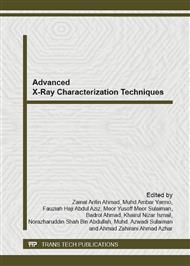p.203
p.208
p.213
p.219
p.224
p.230
p.236
p.241
p.246
Characterization of Potential Used Rubber Seed Coat Waste for the Removal of Remazol Brilliant Blue R Reactive Dye
Abstract:
In the present work, activated carbon was prepared from rubber seed coat by physicochemical activation for the removal of Remazol Brilliant Blue R (RBBR) dye from aqueous solution. The effects of dye initial concentration, contact time, solution temperature and pH on RBBR adsorption onto rubber seed coat based activated carbon (RSCAC) were investigated. The adsorption uptake was found to increase with increase in initial dye concentration and contact time. Change in temperature and pH also played an important role to RBBR adsorption capability. Study showed that rubber seed coat is suitable to be used as activated carbon precursor.
Info:
Periodical:
Pages:
224-229
Citation:
Online since:
December 2012
Authors:
Keywords:
Price:
Сopyright:
© 2013 Trans Tech Publications Ltd. All Rights Reserved
Share:
Citation:


